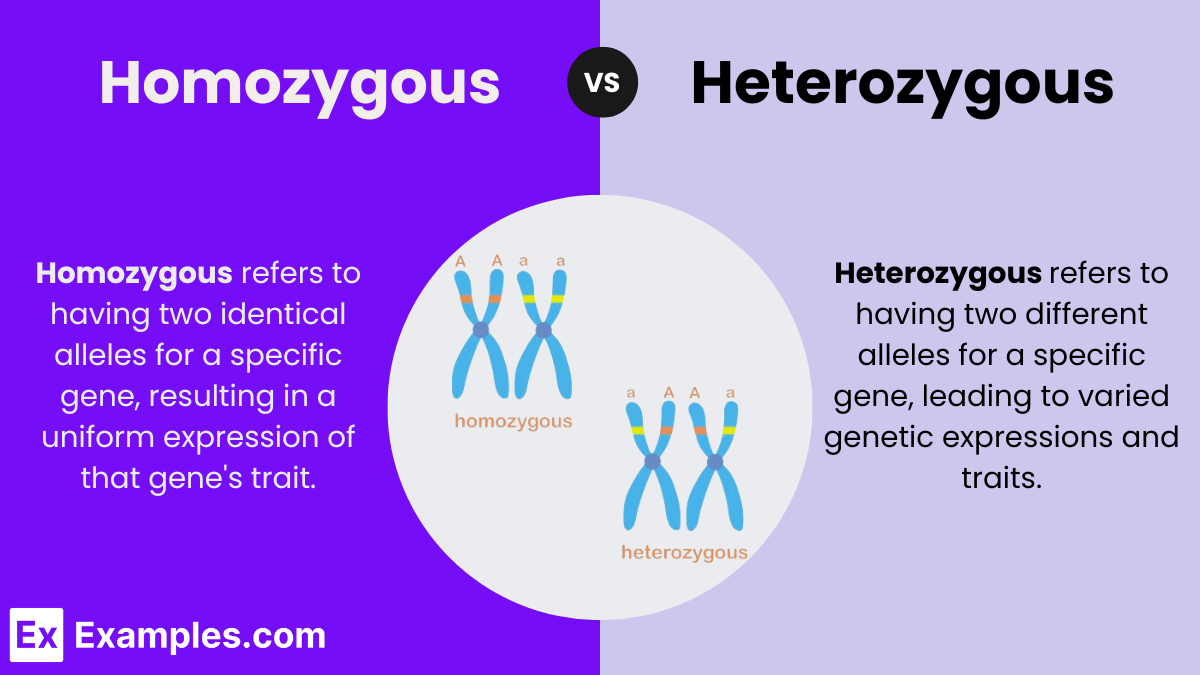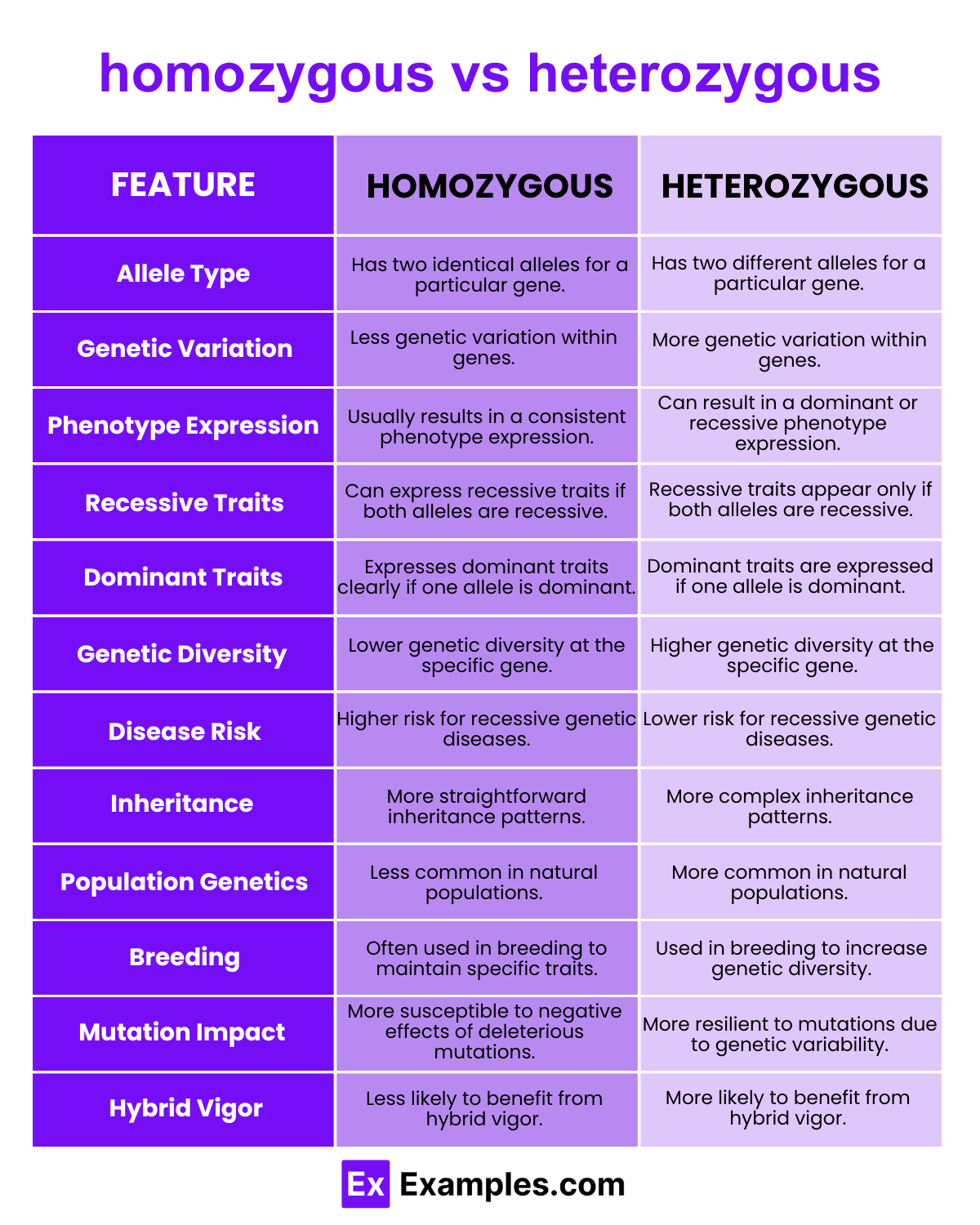What does it mean when an organism is homozygous for a trait?
It has two different alleles for the trait.
It has two identical alleles for the trait.
It has no alleles for the trait.
It has more than two alleles for the trait.

Homozygous and heterozygous are fundamental concepts in genetics that describe the nature of the alleles an organism carries for a particular gene. When both alleles of a gene are identical, we call the organism homozygous. Conversely, if the alleles differ, the organism is heterozygous. These genetic variations determine many of the traits an organism exhibits, from physical characteristics like eye color to the presence of certain diseases. Understanding the distinction between homozygous and heterozygous is crucial for studying inheritance patterns, predicting genetic outcomes, and managing breeding strategies in both agriculture and medicine.
Homozygous refers to having two identical alleles for a specific gene. In genetics, alleles are the different versions of a gene that can exist. When an organism is homozygous for a gene, it means that it inherited the same allele from both of its parents. This genetic condition affects how traits are expressed and inherited.
There are two types of homozygous conditions:
An example of a homozygous genotype in humans can be found in blood type inheritance. Blood type is determined by the ABO blood group system, where the A and B alleles are dominant, and the O allele is recessive. Individuals can inherit two identical alleles from their parents for a particular gene, making them homozygous.
Heterozygous refers to a genetic condition where an individual has two different alleles for a specific gene. In genetics, alleles are the different versions of a gene that can exist at a particular locus (position) on a chromosome. When an organism is heterozygous for a gene, it carries one dominant and one recessive allele, or two different dominant alleles that influence the same trait in different ways.
A practical real-life example of heterozygosity appears in the human blood type system, particularly within the ABO blood group system. Consider a person who carries one allele for type A blood and another for type B blood. This genotype appears as AB, marking the individual as heterozygous for the ABO blood type gene.
In this scenario, a person inherits the A allele from one parent and the B allele from the other parent. Both alleles express themselves equally, resulting in an AB blood type phenotype, which exemplifies codominance. Since neither allele is recessive, the body produces both A and B antigens on the surface of red blood cells.
A gene acts as a fundamental unit of heredity in living organisms. It consists of a specific sequence of nucleotides in DNA that codes for a molecule, usually a protein, playing a critical role in the organism’s structure and function. Below are key aspects that define a gene:

| Aspect | Homozygous | Heterozygous |
|---|---|---|
| Definition | An individual with two identical alleles for a specific gene. | An individual with two different alleles for a specific gene. |
| Allele Type | Both alleles are the same (either both dominant or both recessive). | One dominant allele and one recessive allele, or two different dominant alleles. |
| Genetic Makeup | Can be either homozygous dominant (AA) or homozygous recessive (aa). | Always has one allele of each type (Aa), or different alleles that both influence the trait (AB). |
| Phenotype Expression | The trait associated with the allele is consistently expressed. | The trait expressed depends on the dominance of the alleles (dominant trait usually expressed). |
| Examples | Purebred organisms, such as AA for blue eyes or aa for attached earlobes. | A person with one allele for brown eyes (B) and one for blue eyes (b) typically has brown eyes. |
| Genetic Variability | Low genetic variability as the alleles are the same. | Higher genetic variability due to the presence of different alleles. |
| Impact on Population | Can increase the prevalence of certain traits or genetic disorders if recessive. | Contributes to genetic diversity and adaptability in a population. |
| Practical Implication | More predictable trait transmission in breeding and genetic research. | More complex trait transmission, providing a broader range of outcomes in offspring. |
| Disease Risk | Increased risk of recessive genetic disorders if both alleles are deleterious. | Lower risk for recessive disorders unless both parents pass on a recessive allele. |
| Utility in Research | Useful for studying the effects of specific genes without interference from other alleles. | Important for studying the interaction of different alleles and their combined effect on the phenotype. |
| Biological Impact | May lead to reduced biological fitness if negative traits are amplified. | Increases biological fitness by combining beneficial traits from diverse alleles. |
| Inheritance Patterns | Simple Mendelian inheritance is easier to track and predict. | Can demonstrate more complex inheritance patterns like incomplete dominance or codominance. |
| Role in Evolution | Less advantageous in rapidly changing environments due to lack of genetic diversity. | More advantageous in evolving populations, providing a buffer against detrimental mutations. |
| Molecular Biology Applications | Often used in genetic engineering to create organisms with desired homogeneous traits. | Used in hybridization techniques to produce offspring with desired characteristics from two different strains. |
Despite their differences in genetic makeup, homozygous and heterozygous genotypes share several fundamental similarities that play crucial roles in genetics and heredity. Here are the key similarities:
Homozygous individuals have identical alleles for a gene, while heterozygous individuals have different alleles.
Heterozygous can include one dominant and one recessive allele, with the dominant trait typically expressed.
An example of heterozygous is a person having one allele for brown eyes and one for blue, usually displaying brown eyes.
Determine if a mutation is homozygous or heterozygous by comparing DNA sequences from both alleles for consistency or variation.
The easiest way is genetic testing or observing trait inheritance patterns across generations.
Text prompt
Add Tone
10 Examples of Public speaking
20 Examples of Gas lighting
What does it mean when an organism is homozygous for a trait?
It has two different alleles for the trait.
It has two identical alleles for the trait.
It has no alleles for the trait.
It has more than two alleles for the trait.
An organism with genotype Bb for a trait is:
Homozygous dominant
Homozygous recessive
Heterozygous
Codominant
Which of the following represents a homozygous recessive genotype?
BB
Bb
bb
bB
What is the phenotype of an organism that is heterozygous for a dominant trait?
It exhibits the recessive trait.
It exhibits a blend of both traits.
It exhibits the dominant trait.
It does not exhibit any trait.
In Mendelian genetics, what does the term "homozygous" refer to?
Two dominant alleles
Two recessive alleles
Either two dominant or two recessive alleles
One dominant and one recessive allele
If an individual is homozygous dominant for a trait, their genotype could be:
Aa
AA
aa
Ab
What type of allele combination do homozygous individuals have?
Only one allele
Two different alleles
Two identical alleles
No alleles
In a heterozygous genotype, what happens to the recessive allele?
It is expressed equally with the dominant allele.
It is masked by the dominant allele.
It becomes dominant.
It disappears.
Which term describes an organism with two different alleles for a particular trait?
Homozygous
Homologous
Haploid
Heterozygous
For a flower color trait where purple (P) is dominant and white (p) is recessive, what is the phenotype of a Pp genotype?
Purple
White
Pink
Colorless
Before you leave, take our quick quiz to enhance your learning!

